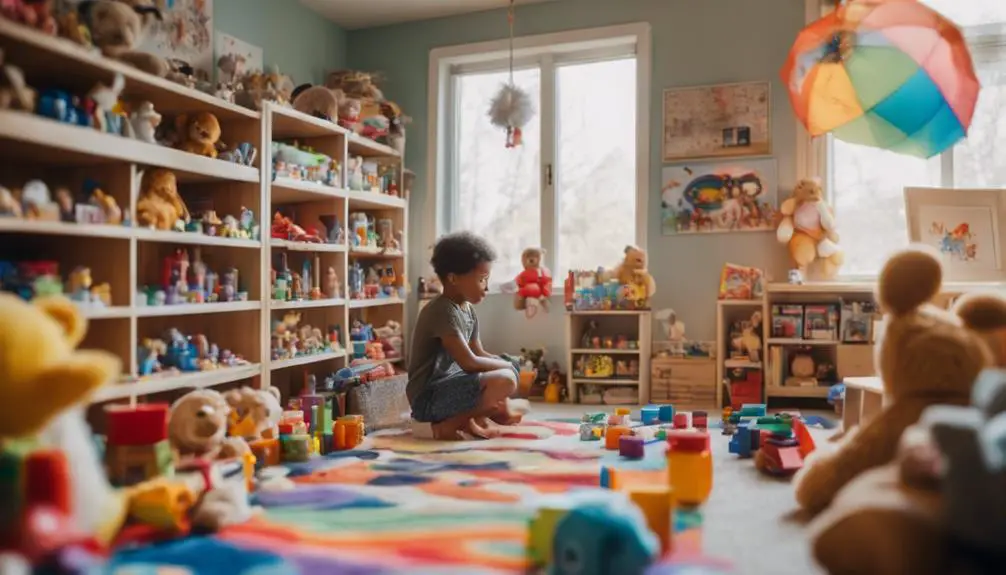The 20 Toy Rule, inspired by Marie Kondo’s decluttering principles, encourages a fresh perspective on how your child’s play area influences their growth. Limiting toys to just twenty can transform the space into one that promotes creativity and concentration rather than disorder.
This strategy goes beyond merely cutting down on clutter; it aims to improve the quality of playtime. Consider the amazing changes that could occur in your child’s imaginative play when they aren’t faced with an overwhelming array of choices. This minimalist strategy can lead to a more engaged and meaningful play experience, allowing children to explore their creativity more deeply.
For instance, a set of building blocks, a few art supplies, a couple of favorite books, and a select number of action figures or dolls could make up the twenty toys. These items can stimulate children’s imagination and encourage them to invent their own stories and scenarios, leading to richer play experiences.
Implementing the 20 Toy Rule can also strengthen family dynamics by encouraging shared playtime, where parents and children engage more fully with the limited toys available. This approach not only cultivates a sense of organization but also fosters deeper connections through play, making every moment spent together more special.
Understanding the 20 Toy Rule
The 20 Toy Rule offers an effective way to manage your child’s toy collection. This straightforward idea encourages limiting toys to just 20 at any one time. This approach creates a sense of freedom for both you and your child, making playtime more enjoyable and less overwhelming.
Focusing on quality over quantity allows you to choose toys that align with your child’s interests and support their developmental needs. Start by assessing the toys you currently have and identifying which ones truly bring joy or foster creativity.
After narrowing it down to the 20 most meaningful toys, consider implementing a toy rotation system. This involves keeping some toys stored away while your child engages with the selected 20. After a few weeks, swap out some of the active toys for those in storage.
This strategy keeps playtime dynamic and exciting, allowing your child to rediscover old favorites without the clutter that can often overwhelm them. For example, if your child loves building blocks, ensure those are part of the 20 toys.
When you rotate, you might substitute the blocks with puzzles or art supplies, providing a fresh variety that maintains their interest in play. This method not only reduces mess but also encourages your child to explore their creativity and develop new skills with different types of play materials.
Benefits of Minimalism for Kids
Minimalism can significantly enhance both your child’s environment and mindset, creating a space that promotes peace and focus. Embracing the idea of simplicity in childhood allows your child to explore and engage with their surroundings without the distraction of too many toys.
With fewer items to divert their attention, they can dive into imaginative play, which is crucial for developing creativity and problem-solving abilities.
Simplifying the selection of toys teaches your child to prioritize quality over quantity. When they aren’t faced with an overwhelming array of choices, they can better appreciate the distinct purpose and potential of each toy.
This mindful approach not only alleviates stress but also fosters a greater appreciation for the things they possess.
Minimalism also instills a sense of responsibility. When children recognize that their toys are limited, they tend to take better care of them.
This understanding helps them learn the value of maintenance and care—skills that are important throughout their lives.
Creating a minimalist environment allows your child to flourish within their own space. It nurtures their ability to concentrate, create, and connect with themselves and the world around them, establishing the groundwork for a balanced and meaningful childhood experience.
For instance, consider selecting a few high-quality toys, such as building blocks or art supplies, that encourage open-ended play and creativity. This thoughtful curation can make a significant difference in their development.
How to Implement the Rule
Implementing the 20 Toy Rule is a simple yet effective way to enhance your child’s playtime and create a more organized environment. Begin by selecting 20 toys that inspire joy and creativity. Involving your child in this selection process can foster a sense of ownership and engagement. After choosing the toys, establish a rotation schedule to keep playtime fresh and maintain a tidy space.
Here’s a clear plan to help you:
| Week | Toys in Rotation | Sibling Collaboration |
|---|---|---|
| 1 | Toys 1-5 | Share and play together |
| 2 | Toys 6-10 | Build projects as a team |
| 3 | Toys 11-15 | Host a game night |
| 4 | Toys 16-20 | Enjoy an art and craft session |
| 5 | Mix of all | Organize a toy swap |
Encouraging siblings to collaborate during playtime is vital for developing their social skills and creativity. When they work together, they learn crucial lessons in communication, sharing, and creating lasting memories. By rotating toys and promoting cooperative play, you will not only reduce clutter in your home but also nurture a love for imaginative and unstructured play. This approach ensures that playtime remains enjoyable and enriching for your children.
Choosing the Right Toys
Selecting suitable toys for your child significantly impacts their growth and joy. It’s important to consider their developmental stage when making toy choices. Opt for toys that provide just the right level of challenge, helping to enhance skills such as problem-solving, creativity, and motor coordination.
Encourage your child’s curiosity by choosing toys that promote open-ended play, allowing their imagination to flourish.
Durability is another essential aspect to consider. Investing in high-quality toys ensures they can endure wear and tear over time. Look for products made from sturdy materials with versatile designs that can engage your child for years, minimizing the need for constant replacements.
Toys that adapt to your child’s evolving interests and abilities are especially beneficial, as they can grow alongside them.
Fewer toys can lead to more meaningful play experiences. A well-curated selection allows your child to engage more deeply with their imaginative play.
Involving your child in the toy selection process fosters a sense of ownership and ensures they’re drawn to toys that resonate with their interests.
Thoughtful toy choices lay the groundwork for enjoyable and enriching play, nurturing your child’s overall development.
The Impact on Playtime
The quantity of toys available to your child significantly influences their playtime experience. Limiting the number of toys available can enhance play dynamics, enabling your child to engage more thoroughly in imaginative activities. With fewer distractions, your little one can construct unique stories and scenarios, which nurtures creativity and problem-solving abilities.
Here are four advantages of implementing the 20 Toy Rule:
- Concentrated Play: A reduction in clutter allows your child to focus on one or two toys, leading to a more immersive play experience. For instance, if your child has a puzzle and a set of building blocks, they can spend extended time solving the puzzle or constructing imaginative structures instead of jumping from one toy to another.
- Enhanced Creativity: When faced with fewer choices, children are prompted to think creatively, finding innovative ways to interact with their toys. For example, a simple stuffed animal can transform into a character in countless adventures, encouraging storytelling and role-play.
- Strengthened Social Skills: Limiting the number of toys can foster an environment for sharing and teamwork with peers, which ultimately enhances social interactions. For instance, if a playdate includes just a couple of board games, children will need to collaborate and communicate more effectively to enjoy their time together.
- Streamlined Cleanup: A smaller collection of toys simplifies the process of tidying up, teaching children about responsibility and organization. For example, having a designated basket for 20 toys can make it easier for your child to understand where everything belongs, making cleanup a quick and manageable task.
Incorporating the 20 Toy Rule can transform your child’s playtime into a more valuable experience, paving the way for deeper engagement, creativity, social development, and organization skills.
Encouraging Creativity and Imagination
Encouraging creativity and imagination in your child goes beyond simply offering a variety of toys; it involves establishing an environment that ignites their curiosity and inventiveness. The goal is to nurture a space where imaginative play flourishes. This requires allowing your child to explore freely, with minimal distractions from an overwhelming number of toys or strict expectations.
Consider limiting your child’s toys to 20. This reduction can significantly enhance their playtime experience. With fewer distractions, they’re likely to engage more deeply in creative exploration, transforming everyday objects into sources of adventure. For instance, a cardboard box can morph into a spaceship one day and a castle the next—it’s all about how they view their surroundings.
Encouraging your child to articulate their ideas through art, storytelling, or by constructing their own imaginative projects is vital. Pose open-ended questions that stimulate their thinking and assist them in crafting their own narratives. Allowing your child the autonomy to invent their own games and scenarios not only nurtures their problem-solving abilities but also builds their confidence.
Providing them with art supplies, such as colored pencils, sketchbooks, or clay, can further enhance their creative expression. Regularly engaging in storytelling sessions, where they can share their own tales or collaborate on narratives, can also be beneficial.
This approach not only fuels their imagination but also fosters communication skills. Overall, creating an environment rich in opportunities for creative exploration is essential for your child’s development.
Reducing Clutter in the Home
A cluttered home can quickly become overwhelming, hindering both you and your child’s ability to focus on creative play. Reducing clutter goes beyond simple tidying; it’s about cultivating an environment that fosters freedom and sparks imagination.
Here are some practical strategies to help you create a more organized space:
- Establish a Toy Limit: Implementing a 20 Toy Rule can be beneficial. This guideline encourages you to select only the most cherished toys, ensuring your child has the freedom to explore and engage without being distracted by an excess of options.
- Implement Toy Rotation: Regularly exchanging toys keeps the play environment dynamic and interesting. This practice not only maintains your child’s enthusiasm but also minimizes clutter by ensuring that only a limited number of toys are accessible at any given time.
- Encourage Toy Donation: Involving your child in selecting toys they no longer use for donation can be a valuable lesson in generosity. This approach not only clears space but also instills important values by teaching them the joy of giving.
- Designate Play Zones: Creating specific areas for various types of play can significantly enhance organization. By defining locations for different activities, you make it easier for your child to understand where items belong, which simplifies clean-up and promotes independence.
These strategies contribute to a more serene and organized home environment, allowing both you and your child to enjoy creative play without the distraction of clutter.
Teaching Kids Responsibility
Establishing a tidy play area not only minimizes mess but also lays the groundwork for teaching children about responsibility. When kids have a limited selection of toys, they can grasp important lessons regarding ownership and maintenance. Encouraging them to take responsibility for their belongings nurtures a sense of pride and independence.
| Responsibility Lessons | Toy Ownership |
|---|---|
| Learn to clean up after play | Understand the value of keeping toys secure |
| Take turns and share toys | Appreciate the importance of caring for belongings |
| Make decisions about what to keep | Develop a sense of pride in ownership |
For instance, when children learn to clean up after playing, they not only tidy their space but also gain an understanding of the effort required to maintain their environment. Sharing and taking turns with toys teaches them about cooperation and the significance of respecting others’ belongings. Furthermore, when children decide which toys to keep or donate, they experience the joy of ownership and the responsibility that accompanies it. By creating an organized play environment, parents can instill these crucial lessons and foster a sense of accountability in their children.
The Role of Parents
Parents play a crucial role in applying the 20 Toy Rule, helping their children develop a more organized and responsible approach to playtime. Your participation is key in shaping how kids view their toys and understand the value of decluttering.
Here are some practical ways you can make a significant impact:
- Encourage Open Dialogue: Discuss with your children which toys they cherish and what makes those toys special to them. This involvement helps them feel included in the decision-making process regarding their belongings.
- Assist in Toy Choices: Guide them in selecting toys that foster creativity and learning. Prioritize high-quality toys that enhance their play experience rather than accumulating numerous items that may not be used.
- Demonstrate Accountability: Show your children how to take care of their toys and maintain an organized play area. Your behavior serves as a powerful example that they’re likely to imitate.
- Establish Playtime Guidelines: Create rules that promote sharing and respect for others’ toys during playtime. This practice not only cultivates a sense of community but also instills a sense of responsibility in your children.
Setting Limits on Toy Purchases
Establishing limits on toy purchases is essential for keeping your home organized and teaching children important lessons about moderation. Implementing effective strategies for toy buying can help ensure that your child’s collection remains both manageable and meaningful.
Start by setting a monthly budget for toys. This approach not only controls spending but also encourages children to select toys thoughtfully.
Encouraging kids to evaluate their desires for toys promotes a greater appreciation for quality rather than quantity. This shift allows them to fully enjoy their favorite items.
Furthermore, consider a one-in, one-out approach: if they want a new toy, they must donate one they no longer play with. This method not only reduces the number of toys in your home but also instills values of generosity and sharing.
When it’s time to donate toys, look into local charities and shelters that accept gently used items. Many organizations are eager to provide these toys to children in need, giving them a second life.
Organizing Toys Effectively
In the task of organizing toys, addressing clutter directly is essential. Begin with practical decluttering strategies that can significantly improve the situation. For instance, consider sorting toys into categories—such as action figures, building blocks, and art supplies—to make it easier to identify what to keep, donate, or discard.
Once you have streamlined the collection, explore effective storage solutions. Options like clear plastic bins with labels or open shelving can help maintain order while allowing children to easily locate their favorite toys.
Using storage furniture that doubles as seating, such as ottomans with hidden compartments, can also maximize space. Additionally, wall-mounted shelves can display toys while keeping them off the floor, promoting a tidier environment.
Ensuring that storage solutions are accessible empowers kids to take responsibility for their toys, fostering a sense of ownership and organization skills.
Implementing these strategies not only creates a more organized play area but also encourages children to engage in creative play without the distraction of clutter. A well-organized space can enhance their focus and enjoyment, making playtime more fulfilling.
Decluttering Strategies for Toys
Amid the chaos of playtime, organizing toys effectively can feel overwhelming. However, reclaiming your space can lead to a more enjoyable play environment. Here are some practical decluttering strategies to help streamline your toy collection:
- Implement toy rotation: Keep a selection of toys accessible while storing the remainder away. Regularly switching out the toys keeps playtime fresh and exciting for children, encouraging them to engage with their favorites without becoming overwhelmed by options.
- Set limits: Establish a specific number of toys for each category, such as a maximum of ten stuffed animals or a designated box for building blocks. This strategy helps maintain balance in your home and encourages children to select their most cherished items, fostering a sense of choice.
- Encourage mindful gifting: During birthdays or holidays, suggest gifts that are meaningful and serve a purpose. This practice can significantly reduce the influx of toys that often end up forgotten or unused, ensuring that each gift holds value and contributes to your child’s play experience.
- Involve your kids: Engage your little ones in the decluttering process. Allow them to voice which toys they genuinely love and which ones they’d be willing to donate. This not only teaches them about responsibility but also empowers them to take ownership of their space and belongings.
Storage Solutions for Kids
Finding suitable storage solutions for kids can turn a messy playroom into a tidy and functional space. Implementing a toy rotation system allows you to keep a limited selection of toys readily available while storing the rest. This approach not only creates more room but also generates excitement as your child uncovers long-forgotten favorites.
Grouping similar items together—such as blocks with blocks and dolls with dolls—makes it simpler for kids to locate the toys they want, enhancing their playtime experience.
Toy donation offers significant benefits, teaching children the importance of sharing and contributing to their community. Engaging them in the donation process can create meaningful memories while reinforcing their understanding of helping others.
To make storage more enjoyable, personalize storage solutions with vibrant bins or labels that resonate with your child’s interests, adding a touch of fun to organization.
Incorporating storytelling during playtime can elevate the storage experience. Encourage your child to invent stories featuring their toys, which nurtures creativity and deepens their emotional connection to their belongings.
Opt for eco-friendly storage options to promote sustainability, instilling a sense of responsibility in your child regarding their possessions.
Effective storage solutions enhance the educational aspect of play, creating an environment that fosters both learning and growth. With a well-organized space, children can fully enjoy their toys, leading to memorable experiences without the burden of clutter.
Consider using stackable bins for easy access or drawer organizers to separate smaller items, ensuring that every toy has a designated spot.
The Importance of Quality Over Quantity
When you place importance on quality rather than quantity in your child’s toys, you significantly enhance their playtime experience. Selecting a smaller number of carefully chosen toys can ignite creativity and imagination, resulting in more meaningful engagement.
With fewer toys cluttering their space, your child can concentrate better and fully enjoy their time spent playing. For instance, instead of overwhelming your child with numerous plastic figures, consider investing in a high-quality wooden building set. Such a toy not only lasts longer but also encourages open-ended play, allowing your child to construct various structures and scenarios.
This type of engagement promotes problem-solving skills and fosters a sense of accomplishment. Moreover, a tidy play area contributes to a more enjoyable atmosphere. When a child isn’t distracted by excessive toys, they’re more likely to immerse themselves in imaginative play.
Establishing a routine of rotating toys can also keep their environment fresh and stimulating, ensuring that the toys they do have are utilized to their fullest potential. Overall, choosing fewer, high-quality toys can create a more enriching play experience, helping your child develop important skills while enjoying their time to the fullest.
Enhanced Playtime Experience
Quality toys can transform playtime into a vibrant and imaginative experience. When you prioritize a select few high-quality toys, you unlock endless possibilities for your children. Instead of overwhelming clutter, you cultivate an environment where sensory exploration, imaginative storytelling, and cooperative games flourish.
Here are some effective ways to enhance playtime:
- Role-Playing Activities: Encourage your child to step into various characters and scenarios. This practice not only boosts their social skills but also enhances creativity. For example, a simple costume set can inspire hours of imaginative play, allowing your child to act out different roles and situations.
- Outdoor Exploration: Select toys that spark adventure outside, fostering a connection with nature and encouraging curiosity. Consider outdoor playsets or nature exploration kits that include magnifying glasses and bug catchers. These tools invite children to discover the world around them while engaging in physical activity.
- Art Projects: High-quality art supplies can lead to extensive creative expression, enabling your child to experiment and convey their thoughts visually. Invest in a set of watercolor paints, sketchbooks, and varied brushes to provide your child with the tools they need to unleash their artistic potential.
- Building Challenges: Toys that encourage construction and problem-solving foster critical thinking and teamwork. Building blocks or construction sets, such as LEGO, can engage children in collaborative projects, teaching them to work together to achieve a common goal while developing their engineering skills.
Fostering Creativity and Imagination
Fostering creativity and imagination in children is best achieved by emphasizing quality over quantity when it comes to toys. When you select a few high-quality items, it paves the way for boundless creative play. Instead of inundating your child with a multitude of options, opt for toys that ignite imaginative exploration. Consider items that stimulate curiosity, such as building blocks, art supplies, or open-ended games that promote storytelling and role-playing.
Limiting the number of toys allows children to immerse themselves more fully in their play. This focused approach encourages them to improvise, think critically, and develop problem-solving skills. With fewer distractions, each toy transforms into a powerful medium for creative expression. For instance, a simple block could morph into a spaceship, or a blanket might become a fort, enabling children to refine their imaginative capabilities.
Encouraging this type of play is vital because it nurtures the ability to think outside conventional boundaries and fosters independence. Embracing the principle of quality over quantity creates an environment where a child’s imagination can flourish.
This leads to richer, more meaningful play experiences that can significantly influence their development throughout their lives.
Fewer Clutter, More Focus
Simplifying your child’s play environment can lead to better focus and creativity. When you embrace the concept of having fewer toys, you promote mindful consumption, which allows your child to truly appreciate what they own. Instead of overwhelming them with too many options, consider implementing a toy rotation strategy. This approach offers several benefits:
- Increased Focus: With a limited number of toys available, your child can dedicate their attention to one activity at a time, fostering deeper engagement.
- Enhanced Creativity: Constraints can ignite imagination, as children learn to invent new games and stories using the toys they’ve on hand.
- Less Clutter: A clean play area creates a sense of calm, making it easier for your child to explore and learn.
- Greater Appreciation: Rotating toys allows your child to rediscover old favorites, which can lead to a more profound appreciation for each toy’s unique possibilities.
Integrating these principles into your home cultivates an environment where creativity can flourish.
Alternatives to Traditional Toys
Considering the advantages of alternatives to traditional toys can significantly enhance your child’s play experience. Eco-friendly options not only spark creativity but also support environmental sustainability. Choosing materials that are better for the planet helps teach children the importance of responsibility. Educational toys offer engaging learning experiences, often surpassing what conventional toys can provide.
Here’s a look at some engaging alternatives:
| Eco-Friendly Alternatives | Educational Toys | Benefits |
|---|---|---|
| Wooden Blocks | STEM Kits | Encourages problem-solving |
| Recycled Cardboard Toys | Language Learning Games | Boosts communication skills |
| Nature Exploration Kits | Art & Craft Supplies | Sparks creativity |
| Fabric Dolls | Puzzles | Develops critical thinking |
| Plant Growing Kits | Musical Instruments | Promotes sensory development |
Wooden blocks are a classic choice that encourages imaginative building and enhances fine motor skills. STEM kits introduce children to the basics of science, technology, engineering, and math through hands-on activities that captivate their interest. Recycled cardboard toys promote sustainability while allowing kids to create and customize their own playthings, encouraging innovative thinking.
Language learning games not only make acquiring new languages fun but also improve communication skills. Nature exploration kits get children outside and engaged with their environment, fostering a sense of wonder and curiosity about the world. Art and craft supplies can nurture creativity and allow self-expression, while puzzles and musical instruments help develop critical thinking and sensory awareness, respectively.
These alternatives provide valuable experiences that contribute to a child’s overall development, making playtime both enjoyable and meaningful.
Involving Kids in the Process
Involving your kids in choosing toys can significantly enhance the experience. Encouraging open communication allows them to share their genuine interests and preferences. This approach not only boosts their decision-making skills but also leads to the creation of collaborative lists, making the entire process more engaging for everyone involved.
For instance, when you visit a toy store, take the time to discuss different options with your children. Ask them what types of toys they find appealing and why. This could range from action figures to arts and crafts supplies. When they express their preferences, it helps you understand their likes and values better.
Additionally, you might consider setting a budget together. This teaches them about financial responsibility while allowing them to prioritize their choices. If they’re drawn to a particular toy, discuss its features and how it compares to others. This not only sharpens their analytical skills but also makes them feel more invested in the final decision.
Creating a shared list of favorite toys can also be a fun activity. You could sit down with paper and markers to draw or write down their selections. This visual representation of their interests makes the experience more memorable and helps them feel involved in the process.
Ultimately, this collaborative approach not only makes toy selection more enjoyable but also strengthens the bond between you and your children.
Encourage Open Communication
Involving your kids in choosing toys not only gives them a sense of empowerment but also fosters open communication. This approach helps create a space where they feel safe to express their thoughts and emotions.
Here are some effective strategies to promote emotional expression:
- Invite Their Preferences: Encourage your children to share which toys they prefer and the reasons behind their choices. Understanding their interests allows for a deeper connection and insights into their personalities.
- Talk About Toy Significance: Engage in discussions about what makes a toy special or meaningful. This opens the door to conversations about their feelings, helping them articulate what those toys represent to them.
- Promote Inquiry: Encourage your children to ask questions about your toy selections. This not only sparks their curiosity but also enhances their critical thinking skills, enabling them to better express their emotions and opinions.
- Share Personal Stories: Discuss your own favorite toys from childhood. This strengthens your bond and demonstrates that sharing emotions and memories is important and valued in your relationship.
Foster Decision-Making Skills
Encouraging open communication creates valuable opportunities for children to enhance their decision-making abilities. Involving your kids in the toy selection process teaches them essential strategies that enable them to express their preferences and engage in critical thinking.
Begin by discussing together what criteria should guide your choice of toys. Ask them about the types of toys they like and what qualities they consider important. This approach not only instills a sense of ownership but also helps them grasp the reasoning behind their selections.
As they evaluate their options, provide guidance on factors such as age appropriateness, educational benefits, and durability. Engaging in this collaborative conversation encourages children to reflect on their preferences carefully.
For instance, you could ask, “Which toy do you think will endure the longest?” or “In what ways could this toy aid you in learning something new?” This process of evaluating choices together builds their decision-making skills and fosters a deeper understanding of the selection process.
Incorporating specific examples, such as selecting between a building block set or a science kit, can further enhance their understanding. Discuss how each option aligns with their interests and developmental needs, making the decision-making experience both fun and educational.
Create Collaborative Lists
Creating collaborative lists can be an enjoyable and interactive way to involve your kids in choosing toys. Engaging children in the decision-making process teaches them about making choices while also instilling a sense of ownership and responsibility.
To facilitate this, organize family toy meetings where everyone can contribute their ideas. Here’s how to begin:
- Gather everyone: Schedule a date for your family toy meeting. Make it a memorable occasion to encourage participation!
- Brainstorm together: Invite your kids to share their thoughts on the toys they desire or require. There are no limits to their imagination during this phase!
- Create the list: Jot down all the suggestions, ensuring that every family member is heard. This is where your collaborative toy selection takes shape.
- Narrow it down: Together, decide on the final selection of 20 toys. Allow your kids to express their preferences on what should remain and what should be eliminated.
This method not only enhances decision-making but also strengthens family connections. Your children will feel appreciated and empowered, having played a part in crafting the final list.
Evaluating Toys Periodically
Regularly reviewing toys is crucial for maintaining a tidy and stimulating play environment. Frequent examination of your collection allows you to manage the toy lifecycle effectively, ensuring your child has access to items that inspire joy and creativity.
Set aside time every few months to evaluate the toys. Focus on which ones your child enjoys the most and which have been ignored.
If you observe toys collecting dust, assess whether they’re still suitable for your child’s age or engaging enough. This presents an excellent chance to participate in toy donation initiatives. Donating toys not only helps clear your space but also teaches your child about the value of sharing and generosity.
When assessing toys, consider their condition, functionality, and your family’s current needs. Retain those that foster imaginative play and remove those that no longer serve a purpose.
This process creates a dynamic play area that adapts to your child’s evolving interests. Embracing regular toy reviews leads to a less cluttered environment, which can enhance both your space and your child’s experience.
The Emotional Aspect of Toys
Toys often hold significant emotional significance, acting as carriers of memories and connections throughout a child’s journey. They transform from mere objects into sources of comfort and attachment, influencing emotional growth and development. Here are some key ways in which toys contribute to a child’s emotional landscape:
- Comfort Items: Children frequently rely on specific toys for emotional support, which aids in managing feelings during challenging situations. For instance, a soft stuffed animal may provide solace during bedtime, helping a child feel secure.
- Imaginative Play: Toys stimulate creativity, allowing children to explore various scenarios. This kind of imaginative engagement enhances social skills and helps build relationships with peers. For example, a set of building blocks can lead to collaborative play, where children learn teamwork and communication.
- Sensory Experiences: Toys offer a range of sensory inputs that are vital for cognitive growth and emotional reactions. For instance, textured toys can help children develop fine motor skills while also providing tactile stimulation that can soothe or excite them.
- Nostalgic Value: In adulthood, these toys often trigger warm memories, reminding us of simpler, carefree times. This connection can foster a sense of continuity and identity as individuals reflect on their past.
Through play therapy, children have the opportunity to express emotions that they might struggle to verbalize. The influence of toys extends far beyond enjoyment; they serve as tools for developing essential life skills.
Recognizing the emotional significance of toys means understanding that you’re giving your child more than just an object; you’re providing them with a source of comfort, a spark for creativity, and a channel for connection.
Embrace the powerful role these emotional bonds play in nurturing your child’s growth and development.
Simplifying Gift-Giving Occasions
Gift-giving can often feel overwhelming, but it doesn’t have to be. Streamlining your gift selection process allows you to focus on thoughtful choices that truly matter. Simplifying these occasions can lead to more meaningful gifts, fostering genuine connections and demonstrating care for the recipient.
Start by identifying the recipient’s interests and preferences. For instance, if a friend loves cooking, consider giving them a high-quality chef’s knife or a subscription to a gourmet meal kit service. This approach not only shows that you understand their passion but also enhances their cooking experience.
Another effective method is to set a budget upfront. Establishing a spending limit helps narrow down options and prevents stress over financial constraints. You might decide to spend no more than $50 on a birthday gift, allowing you to focus on finding something special within that range.
Consider experiences rather than physical items. Gifting an experience, such as concert tickets or a spa day, can create lasting memories. This type of gift often holds more significance than a traditional item, as it provides an opportunity for shared enjoyment.
Finally, don’t forget the power of personalization. Including a heartfelt note or customizing an item can elevate a simple gift into something truly unique. For example, a monogrammed tote bag not only serves a practical purpose but also adds a personal touch that the recipient will cherish.
Streamlining Gift Selection Process
Navigating the complexities of selecting a gift can often feel daunting, especially during significant occasions. You want to choose something that carries meaning, yet the array of options may seem limitless.
Streamlining your gift selection process allows you to concentrate on what’s truly important. Here are several strategies to simplify your decision-making:
- Understand Their Interests: Observing what the recipient enjoys can significantly narrow down potential gift ideas. For instance, if they love reading, consider books or literary-themed accessories.
- Focus on Toy Categories: Think in terms of specific types of toys, such as educational toys, outdoor play equipment, or arts and crafts supplies. This approach helps select gifts that resonate with the recipient’s preferences. For example, if the child enjoys science, a chemistry set could be an excellent choice.
- Set a Budget: Establishing a clear spending limit can lead to more thoughtful choices while minimizing overwhelm. It encourages you to consider gifts that provide value and meaning within that financial range.
- Encourage a Wishlist: Asking the recipient to share their favorite types of toys can provide a clear roadmap for your selection. This practice not only ensures you choose something they’ll love but also removes guesswork from the process.
Encouraging Thoughtful Giving Choices
Understanding the value of thoughtful giving can significantly change how you celebrate special occasions. When you embrace the concept of meaningful gifting, you are not merely selecting items; you are crafting memorable experiences. This approach encourages a culture of mindful consumption, enabling you to make deliberate choices that resonate with both the giver and the receiver.
To streamline your gift-giving process, consider using a structured framework to guide your selections. Here’s a visual representation to inspire your thoughtful choices:
| Category | Examples |
|---|---|
| Experiences | Tickets to a concert, a cooking class |
| Handmade Gifts | Personalized crafts, homemade baked goods |
| Charitable Donations | Donations made in someone’s name, supporting a cause |
Focusing on experiences can create lasting memories. For instance, gifting concert tickets not only provides entertainment but also an opportunity to share an enjoyable evening together. Handmade gifts carry personal touches that demonstrate thoughtfulness and effort, making them unique and cherished. Lastly, charitable donations reflect consideration for the recipient’s values, allowing them to contribute to a cause they care about while celebrating their special day.
This mindful approach to gifting not only enhances your relationships but also promotes a culture of generosity and connection.
Success Stories From Parents
Many parents have discovered that adopting the 20 Toy Rule has significantly enhanced their children’s playtime and overall well-being. This approach not only promotes creativity but also minimizes clutter and strengthens family connections.
Here are some success stories that illustrate the positive effects of the 20 Toy Rule:
1. Toy Swaps: Families have found that organizing toy exchanges with friends not only helps to declutter their homes but also fosters community ties and creates memorable shared experiences.
For instance, one family noted how their children excitedly anticipated the next swap, which became a fun social event.
2. Mindful Purchasing: Parents have become more thoughtful about the toys they buy, prioritizing quality and durability.
This conscious decision-making leads to deeper emotional connections between children and their cherished toys, making playtime more meaningful.
For example, a parent shared how investing in a well-crafted wooden train set became a cherished family heirloom.
3. Playdate Engagement: With fewer toys available, playdates transform into more interactive and engaging experiences.
Children learn important skills such as sharing and teamwork, which enhances their social development.
One mother remarked on how her son, previously shy, became more outgoing as he navigated playtime with friends around fewer toys.
4. Toy Storytelling: Families have embraced storytelling as part of their playtime routine, giving life to toys with unique personalities and narratives.
This practice stimulates imagination and creativity, allowing children to explore their thoughts and feelings through play.
A father recounted how his daughter created elaborate stories for her dolls, which sparked her interest in writing.
Implementing the 20 Toy Rule not only simplifies playtime but also enriches family dynamics, making it a worthwhile approach for any household.
Overcoming Resistance to Change
Adjusting to the 20 Toy Rule can lead to some resistance, particularly from children who’ve strong attachments to their extensive toy collections.
Youngsters may hold tightly to their favorites, worried that parting with toys equates to losing a piece of their freedom. To facilitate this transition, it’s vital to emphasize the importance of flexibility. Help your children understand that having fewer toys can actually enhance their creativity and playtime with the toys they value the most.
Begin by setting clear expectations. Share your reasons for adopting the rule and the advantages it brings to the whole family.
Involve your children in the decision-making process; allow them to select which toys to keep and which to donate. This approach empowers them and transforms the experience from one of loss to an exciting journey.
Encourage your kids to view their remaining toys as unique and deserving of their attention. Remind them that fewer choices can lead to more imaginative play.
As your family adjusts to the 20 Toy Rule, take time to celebrate the newfound space and freedom it provides, shifting the focus from what’s no longer there to the benefits that come with it.
With patience and empathy, your family will embrace this change together.
Long-Term Benefits of Minimalism
Adopting a minimalist lifestyle can significantly enhance your ability to concentrate and gain clarity in various aspects of your life. When distractions are minimized, you may experience improvements in your emotional health, creating a more serene mental space that promotes thoughtful reflection.
Moreover, a simplified living environment can ignite your creativity and imagination, enabling you to explore fresh ideas without the burden of excess clutter.
For instance, consider how a decluttered workspace can foster increased productivity. When your desk is tidy and free of unnecessary items, it becomes easier to focus on the task at hand. This not only streamlines your workflow but also encourages innovative thinking.
Similarly, a minimalist home can create a calming atmosphere that supports relaxation and mindfulness, essential components for maintaining mental well-being.
Enhanced Focus and Clarity
In a world brimming with distractions, embracing minimalism can significantly enhance your focus and clarity. Eliminating chaos from your surroundings allows for more mindful engagement and concentrated activities. This transformation not only increases productivity but also liberates you to pursue what genuinely matters in life.
Here are four ways minimalism can elevate your focus:
- Fewer Distractions: A decluttered environment enables your mind to concentrate on the immediate task, making it simpler to maintain attention.
- Simplified Choices: Reducing the number of options you face lessens decision fatigue, which in turn allows for deeper immersion in your selected activities.
- Enhanced Creativity: A minimalist space fosters mental clarity, igniting creativity and innovative thinking during focused endeavors.
- Mindful Living: By thoughtfully curating your possessions, you cultivate a lifestyle that values quality over quantity, resulting in more meaningful experiences.
As you integrate minimalism into your life, you’ll notice an improvement in your ability to focus and a deepening of your clarity.
When distractions diminish, you enable yourself to live with intention and purpose, fully engaged in each moment.
Improved Emotional Well-Being
Minimalism promotes emotional well-being, leading to transformative effects in your life over time. Simplifying your environment can help you achieve emotional balance, significantly reducing the chaos that often arises from excess. Letting go of unnecessary belongings, particularly those connected to sentimental attachments, frees you from the weight of materialism, enabling a clearer and more focused mindset.
Here’s how minimalism can enhance your emotional health:
| Aspect | Benefits | Long-Term Impact |
|---|---|---|
| Emotional Balance | Decreased stress | Boosted happiness |
| Sentimental Attachments | Reduced clutter | Release from guilt |
| Simplified Choices | Enhanced decision-making | Improved self-awareness |
| Mindfulness | Heightened present-moment awareness | Stronger relationships |
| Clarity | Focus on what truly matters | Sustained inner peace |
Reducing stress leads to increased happiness, as a clutter-free space allows for a more serene environment. When you address sentimental attachments, the act of decluttering can alleviate feelings of guilt tied to those items. Simplifying choices not only streamlines your daily decisions but also fosters greater self-awareness, as you become more in tune with your true preferences.
Practicing mindfulness helps you stay present, which can deepen your connections with others. When you achieve clarity about your priorities, you can concentrate on what genuinely matters, leading to lasting inner peace. Embracing minimalism can be a significant step toward nurturing your emotional well-being and creating a fulfilling life.
Increased Creativity and Imagination
A tidy environment ignites creativity and imagination, allowing the mind to wander without disruptions. Embracing minimalism opens up an array of possibilities, enhancing your child’s capacity for imaginative play.
With a limited selection of toys, children cultivate vital skills such as creative thinking and artistic expression through various activities:
- Storytelling sessions that spark their ideas and characters.
- Role-playing games that promote empathy and an understanding of different viewpoints.
- Sensory activities that invite them to engage with their surroundings.
- Group projects that foster collaboration and inventive play.
Simplifying their space encourages divergent thinking, enabling your child to generate multiple solutions to challenges. This enhances their problem-solving abilities, which are essential throughout life.
The open space created by adhering to the 20 Toy Rule nurtures innovation and exploration, transforming each toy into a means of discovery.
A clutter-free setting not only enhances focus but also allows for deeper engagement in play. As your child interacts with fewer distractions, they’re more likely to immerse themselves in their imaginative worlds, leading to richer experiences and developmental growth.
Conclusion
In the words of Confucius, “The man who moves a mountain begins by carrying away small stones.” Embracing the 20 Toy Rule goes beyond just getting rid of excess toys; it encourages creativity and responsibility in your children. This minimalist approach turns playtime into a vibrant and engaging experience, enabling your kids to rediscover the joy of their toys. Start today by limiting the number of toys, and you will notice how your child flourishes in a more mindful and imaginative environment.
For example, consider setting a timer and having your child choose their 20 favorite toys to keep. This process not only helps in decluttering but also teaches them to value their belongings and make thoughtful decisions. You might even create a special storage box for the rest, which they can revisit later. This practice nurtures their ability to appreciate what they have, leading to deeper engagement during playtime.















